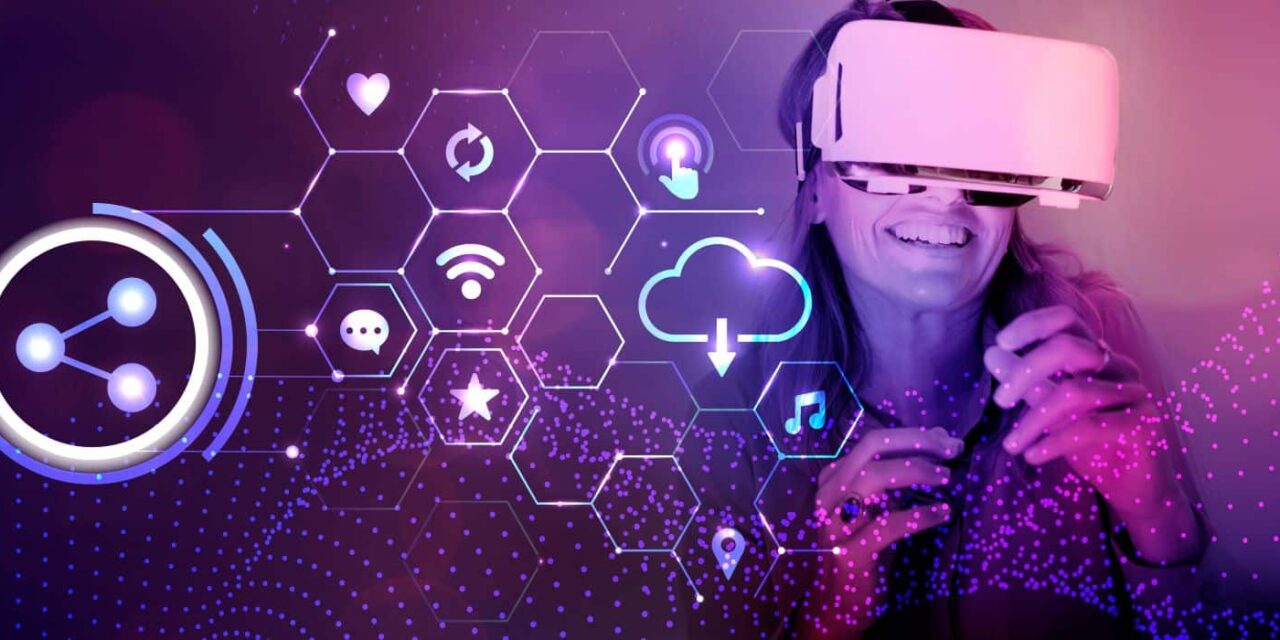Since the Internet boom in the 90s, cyberspace has continued to evolve and grow. There has been the creation of various virtual environments, including social networks, the advent of videoconferences, 3D virtual worlds (virtual reality), augmented reality applications (such as Pokemon Go) and, more recently, the development of NFT. These virtual environments, although not permanent and not connected, allowed us to reach various degrees of digital transformation. The term “metarers” was invented to facilitate the digital transformation of all aspects of our physical life. At the heart of the Metavers is the vision of an immersive internet as a gigantic, uni fi ed, persistent and shared kingdom. If the metarers may seem futuristic, catalyzed by emerging technologies, the digital “big bang” of our cyberspace is not far away.
Today, certain specific types of metavers already exist to describe worlds of play in which users have a character who can interact with other players. There is also a specific type of Metavers that uses Blockchain technologyin which users can Buy virtual land and other digital assets using cryptocurrency. The gamecreated by a French startup, The sandbox This is a perfect example. These spaces look more like a video game than real life and are not the purpose of the future metarers.
Although there is no concrete definition, The metarers can be understood as a virtual environment In which you can enter rather than simply observing it through a screen. It is intended to be a world of infinite and interconnected virtual communities where people can meet,, to work And play Through virtual reality, augmented reality, smartphones applications, etc.
In addition, it should also integrate different aspects of today's “online” life, such as shopping and social networks. The metarers will be the next evolution of connectivity, in which All online elements will be gathered in a homogeneous universe. There virtual life will therefore be lived of the same way as physical life. A concrete example? At the heart of the metarers, it will be possible to access virtual concerts, online trips, buy digital clothes, etc. It will also have An impact on teleworking : meetings will not be done by Visio, but employees will be able to be virtually through a personalized avatar.
Facebook rebranding
The Metavers is about to become flagship social technology. Facebookwho Now renamed Metahas invested massively in virtual and augmented reality. In a video broadcast on the occasion of the announcement of this new bold orientation, Mark Zuckerberg, CEO of Facebook (META), presented a wide range of features to come in the Metavers.
From the creation of dedicated virtual spaces, including meetings with friends or games based on augmented reality. One of the interesting aspects of this presentation was Facebook's commitment has Create virtual workspaces that are also socially robust that their real counterparts.
Metavers' experience is intrinsically social. Shopping is a major aspect. In the current world of Online shoppingmost purchases are limited to a single application, a single website or a single game. If you buy personalized costumes or skins for virtual characters, they cannot be exported and used in other game ecosystems. In the future, Thanks to the metarershe will be possible to buy goods and services with sellers who can be used in many virtual worlds.
The digital object market represents more than $ 10 billion and the Fortnite video game alone has sold more than a billion dollars of digital objects. The problem for buyers of Fortnite objects is that Fortnite digital objects only work in Fortnite and that, if the game disappears, all the objects purchased in this context will become unnecessary. Digital objects that have real value can exist independently of an entity. This means that if Fortnite objects had a real value, they could be used and sold on the free market by individuals, that Fortnite still exists or not. That's an NFT!
NFTs are digital objects which can be sold or purchased on an open marketand possessed and controlled by any individual user, without the authorization or support of a centralized company. The buyer of an NFT therefore does not have to fear the disappearance of a business. Cryptocurrencies can be purchased and sold according to same principles as NFT,, decentralized. When the metarers mature, it could be full of decentralized marketplaces where users could buy and exchange currencies and resources in a wide range of digital worlds.
You have understood, the Metavers is this virtual world where Business opportunities are and will be incredible. Obviously, we are still at the very beginning, but international renown brands, such as Guccihave already Created a virtual space For expose your products.
Who says product, says potential customer. Here, the difficulty is to know who we address. Each person in the real world being represented by an avatar, not easy to know who hides behind. According to expert Metavers Cathy Hackl, Customer relations As we know it today will change. We will now talk about D2A or Direct-to-Avatar.
“The Direct-to-Avatar (D2A) refers to an emerging commercial model which consists in selling products directly to avatars (D2A)-or digital identities-by bypassing any management of the supply chain such as the logistics of the delivery of a physical product to the door of a consumer”, said Ryan Gill, co -founder and CEO of Crucible.
D2A brands are sold in social or competitive virtual environments, such as games or open worlds, where consumers Project each other through their avatar. Kerry Murphy, founder of The manufacturer, an exclusively digital fashion house, describes The economy D2A as being Composed of “Digi-Sapiens“. He said:
“They represent around 3.5 billion people worldwide, with more than 55 % of the total purchasing power. [Les Digi-Sapiens] are made up of generation Z and young millennials, which grew up by blurring reality and the imaginary, the virtual world becoming their second house. »» DIGI-SAPIENS are ” of the Trendy launcherstrend hunters and early adopters of all technology that improves and releases their existence. »»
They also care about the environment, rarity, authenticity and exclusivity. Sewing houses and digital clothing brands solve this problem.
This idea of virtual goods as virtual objects is another emerging domain of increased trade. One of the advantages for marks that hope to be noticed by the young generations. A study by McKinsey has noticed that generation Z considers “consumption as access rather than a possession”. Consumption is “an expression of individual identity” and a subject of ethical concern. The evolution of the consumption mentality is what leads marks to use virtual goods as goods in the emerging field of increased retail sales. Brands to listen to young people and future generations can start thinking now about their Product strategy. Fashion is an example of how an outdated industry is reinventing itself.
Finally, let's finish this article on the Metavers with a few words on advertising. Today, these advertisements appear on the Display network from Google, on social networks on television etc. When you will be immersed in the Metavers, not impossible that you are arrested by a virtual character trying to sell you a barbecue … virtual, for your future virtual evenings. Brands therefore have every interest in think today At Product and Service that it will be possible to sell inside of a Metavers.






